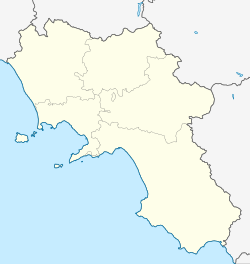world.wikisort.org - Italy
Buccino is a town and comune in Campania in Italy, in the province of Salerno, located about 700 m above sea level.
This article may be expanded with text translated from the corresponding article in Italian. (January 2022) Click [show] for important translation instructions.
|
Buccino | |
|---|---|
Comune | |
| Comune di Buccino | |
 | |
 Buccino within the Province of Salerno | |
Location of Buccino  | |
 Buccino Location of Buccino in Italy  Buccino Buccino (Campania) | |
| Coordinates: 40°38′N 15°23′E | |
| Country | Italy |
| Region | Campania |
| Province | Salerno (SA) |
| Frazioni | Buccino Scalo, Pianelle, San Giovanni, Teglia, Temponi, Tufariello |
| Area | |
| • Total | 65.48 km2 (25.28 sq mi) |
| Elevation | 663 m (2,175 ft) |
| Population (31 December 2004)[2] | |
| • Total | 5,555 |
| • Density | 85/km2 (220/sq mi) |
| Demonym(s) | Buccinesi |
| Time zone | UTC+1 (CET) |
| • Summer (DST) | UTC+2 (CEST) |
| Postal code | 84021 |
| Dialing code | 0828 |
| Patron saint | Santa Maria Immacolata |
| Saint day | Prima domenica di Luglio |
| Website | Official website |
Geography
The municipality borders with Auletta, Colliano, Palomonte, Romagnano al Monte, Salvitelle, San Gregorio Magno and Sicignano degli Alburni. It counts the hamlets (frazioni) of Buccino Scalo, Pianelle, San Giovanni, Teglia, Temponi and Tufariello.
History
In Roman times, the town was known as Volcei. It was the chief town of the independent tribe of the Volceiani, Vulcientes or Volcentani, whose territory was bounded north by that of the Hirpini, west and south by Lucania and east by the territory of Venusia. Some pre-Roman ruins still exist.[3] It became a municipium, and in 323 CE had an extensive territory attached to it, including the town of Numistro, the large Cyclopean walls of which may still be seen, 35 km below Muro Lucano.[4]
Main sights
Below the town is a well-preserved Roman bridge over the Tanagro river.[4]
References
- "Superficie di Comuni Province e Regioni italiane al 9 ottobre 2011". Italian National Institute of Statistics. Retrieved 16 March 2019.
- "Popolazione Residente al 1° Gennaio 2018". Italian National Institute of Statistics. Retrieved 16 March 2019.
- Notizie degli scavi, 1884, 115
- One or more of the preceding sentences incorporates text from a publication now in the public domain: Chisholm, Hugh, ed. (1911). "Volcei". Encyclopædia Britannica. Vol. 28 (11th ed.). Cambridge University Press. p. 192. This cites G. Patroni in Notizie degli scavi (1897), 183.
External links
![]() Media related to Buccino at Wikimedia Commons
Media related to Buccino at Wikimedia Commons
На других языках
- [en] Buccino
[ru] Буччино
Буччино (итал. Buccino) — коммуна в Италии, располагается в регионе Кампания, в провинции Салерно.Другой контент может иметь иную лицензию. Перед использованием материалов сайта WikiSort.org внимательно изучите правила лицензирования конкретных элементов наполнения сайта.
WikiSort.org - проект по пересортировке и дополнению контента Википедии